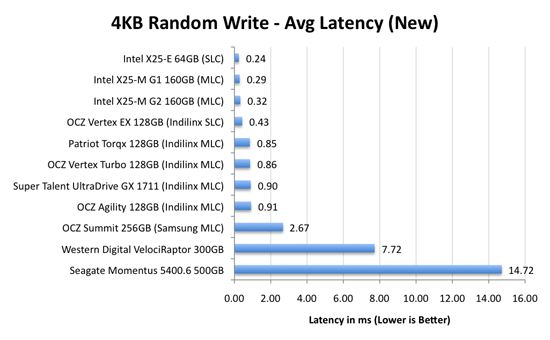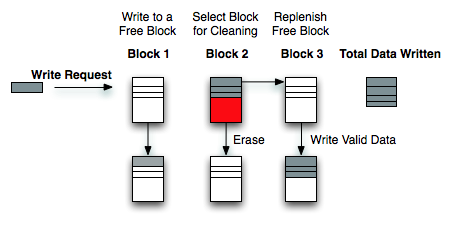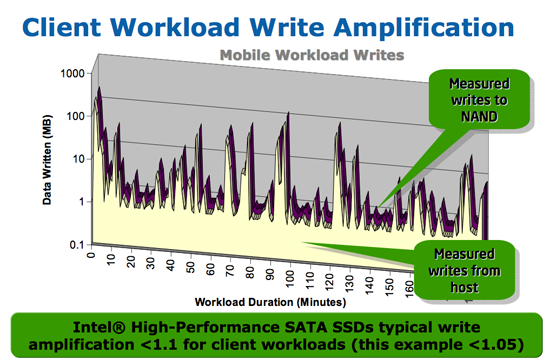The SSD Relapse: Understanding and Choosing the Best SSD
by Anand Lal Shimpi on August 30, 2009 12:00 AM EST- Posted in
- Storage
The Cleaning Lady and Write Amplification
Imagine you’re running a cafeteria. This is the real world and your cafeteria has a finite number of plates, say 200 for the entire cafeteria. Your cafeteria is open for dinner and over the course of the night you may serve a total of 1000 people. The number of guests outnumbers the total number of plates 5-to-1, thankfully they don’t all eat at once.
You’ve got a dishwasher who cleans the dirty dishes as the tables are bussed and then puts them in a pile of clean dishes for the servers to use as new diners arrive.
Pretty basic, right? That’s how an SSD works.
Remember the rules: you can read from and write to pages, but you must erase entire blocks at a time. If a block is full of invalid pages (files that have been overwritten at the file system level for example), it must be erased before it can be written to.
All SSDs have a dishwasher of sorts, except instead of cleaning dishes, its job is to clean NAND blocks and prep them for use. The cleaning algorithms don’t really kick in when the drive is new, but put a few days, weeks or months of use on the drive and cleaning will become a regular part of its routine.
Remember this picture?

It (roughly) describes what happens when you go to write a page of data to a block that’s full of both valid and invalid pages.
In actuality the write happens more like this. A new block is allocated, valid data is copied to the new block (including the data you wish to write), the old block is sent for cleaning and emerges completely wiped. The old block is added to the pool of empty blocks. As the controller needs them, blocks are pulled from this pool, used, and the old blocks are recycled in here.
IBM's Zurich Research Laboratory actually made a wonderful diagram of how this works, but it's a bit more complicated than I need it to be for my example here today so I've remade the diagram and simplified it a bit:

The diagram explains what I just outlined above. A write request comes in, a new block is allocated and used then added to the list of used blocks. The blocks with the least amount of valid data (or the most invalid data) are scheduled for garbage collection, cleaned and added to the free block pool.
We can actually see this in action if we look at write latencies:

Average write latencies for writing to an SSD, even with random data, are extremely low. But take a look at the max latencies:

While average latencies are very low, the max latencies are around 350x higher. They are still low compared to a mechanical hard disk, but what's going on to make the max latency so high? All of the cleaning and reorganization I've been talking about. It rarely makes a noticeable impact on performance (hence the ultra low average latencies), but this is an example of happening.
And this is where write amplification comes in.

In the diagram above we see another angle on what happens when a write comes in. A free block is used (when available) for the incoming write. That's not the only write that happens however, eventually you have to perform some garbage collection so you don't run out of free blocks. The block with the most invalid data is selected for cleaning; its data is copied to another block, after which the previous block is erased and added to the free block pool. In the diagram above you'll see the size of our write request on the left, but on the very right you'll see how much data was actually written when you take into account garbage collection. This inequality is called write amplification.

Intel claims very low write amplification on its drives, although over the lifespan of your drive a < 1.1 factor seems highly unlikely
The write amplification factor is the amount of data the SSD controller has to write in relation to the amount of data that the host controller wants to write. A write amplification factor of 1 is perfect, it means you wanted to write 1MB and the SSD’s controller wrote 1MB. A write amplification factor greater than 1 isn't desirable, but an unfortunate fact of life. The higher your write amplification, the quicker your drive will die and the lower its performance will be. Write amplification, bad.










295 Comments
View All Comments
Wwhat - Sunday, September 6, 2009 - link
If you read the first part of the article alone you would see how important a good controller is in a SSD and you would no ask his question probably, plus SSD's use the flash in parallel where a bunch of USB drives would not, the parallel thing is also mentioned in the article.And USB has a lot of overhead actually on the system, both in CPU cycles as well as in IO interrupts.
There are plug in PCI(e) cards to stick SD cards in though, to get a similar setup, but it's a bit of a hack and with the overhead and the management and controllers used and the price to buy many SD cards it's not competitive in the end and you are better of with a real SSD I'm told.
Transisto - Sunday, September 6, 2009 - link
You are right, the controller is very important.I think caching about 4-8 gig of most often accessed program files has the best price/performance ratio, for improving application load time. It it also very easily scalable.
One of the problem I see is integrating this ssd cache in the OS or before booting so it act where it matter the most.
I think there could be a near x25-m speedup from optimized caching and good controller no matter what SSD form factor it rely on. SD, CF, usb , pci or onboard.
Why it seams nobody talk about eboostr type of caching AND ,,, on other news ,,, Intel's Braidwood flash memory module could kill SSD market.
I am quite of a performance seeker.
But I don't think I need 80gig of SSD in my desktop,just some 8gb of good caching. Mabe a 60gb ssd on a laptop.
Well... I'm gonna pay for that controller once, not twice (160gb?)
Wwhat - Saturday, September 5, 2009 - link
Not that it's not a good article, although it does seem like 2 articles in one, but what I miss is getting to brass tacks regarding the filesystem used, and why there isn't a SSD-specific file system made, and what choices can be made during formatting in regards to blocksize, obviously if you select large blocks on filesystem level a would impact he performance of the garbage collection right? It actually seem the author never delved very deeply into filesystems from reading this.The thing is that even with large blocks on filesystem level the system might still use small segments for the actuall keepin track, and if it needs to write small bits to keep track of large blocks you'd still have issues, that's why I say a specific SSD filesystem migh be good, but only if there isn't a new form of SSD in the near future that makes the effort poinless, and if a filesystem for SSD was made then the firmware should not try to compensate for exising filesystem issues with SSD's.
I read that the SD people selected exFAT as filesystem for their next generation, and that also makes me wonder, is that just to do with licensing costs or is NTFS bad for flash based devices?
Point being at the filesystem needs to be highlighted more I think,
Bolas - Friday, September 4, 2009 - link
Would someone please hit Dell with the clue-board and convince them to offer the Intel SSD's in their Alienware systems? The Samsung SSD's are all that is stopping me from buying an Alienware laptop at the moment.EatTheMeat - Friday, September 4, 2009 - link
Congratulations on another fab masterclass. This is easily the best educational material on the internet regarding SSDs, and contrary to some comments, I think you've pitched your recommendations just right. I can also appreciate why you approached this article with some trepidation. Bravo.I have a RAID question for Anand (or anyone else who feels qualified :-))
I'm thinking of setting up 2 160GB x25-m G2 drives in RAID-0 for Win 7. I'd simply use the ICH10R controller for it. It's not so much to increase performance but rather to increase capacity and make sure each drive wears equally. After considering it further I'm wondering if SSD RAID is wise. First there's the eternal question of stripe size and write amplification. It makes sense to me to set the stripe size to be the same as, or a fraction of, the block size of the SSD. If you choose the wrong stripe size does it influence write amplification?
I'm aware that performance should increase with larger spripes, but I'm more concerned about what's healthy for the SSD.
Do you think I should just let SSD RAID wait until RAID drivers are optimised for SSDs?
I know you're planning a RAID article for SSDs - I for one look forward to it greatly. I've read all your other SSD articles like four times!
Bolas - Friday, September 4, 2009 - link
If SSD's in RAID lose the benefit of the TRIM command, then you're shooting yourself in the foot if you set them up in RAID. If you need more capacity, wait for the Intel 320GB SSD drives next year. Or better yet, use a 160 GB for your boot drive, then set up some traditional hard disk drives in RAID for your storage requirements.EatTheMeat - Friday, September 4, 2009 - link
Thanks for reply. I definitely hear you about the TRIM functionality as I doubt RAID drivers will pass this through before 2010. Still though, it doesn't look like the G2s drop much in performance with use anyway from Anand's graphs. With regard to waiting for 320 GB drives - I can't. These things are just too enticing, and you could always say that technology will be better / faster / cheaper next year. I've decided to take the plunge now as I'm fed up with an i7 965 booting and loading apps / games like a snail even from a RAID drive.I just don't want to bugger the SSDs up with loads of write amplification / fragmentation due to RAID-0. ie, is RAID-0 bad for the health of SSDs like defragmentation / prefetch is? I wonder if anyone knows the answer to this question yet.
jagreenm - Saturday, September 5, 2009 - link
What about just using Windows drive spanning for 2 160's?EatTheMeat - Saturday, September 5, 2009 - link
As far as I know drive spanning doesn't even the wear between the discs. It just fills up first one and then the other. That's important with SSDs because RAID can really help reduce drive wear by spreading all reads and writes across 2 drives. In fact, it should more than half drive wear as both drives will have large scratch portions. Not so with spanning as far as I know.Does anyone know if I'm talking sh1t here? :-)
pepito - Monday, November 16, 2009 - link
If you are not sure, then why do you assert such things?I don't know about Windows, but at least in Linux when using LVM2 or RAID0 the writes spread evenly against all block devices.
That means you get twice the speed and better drive wear.
I would like to think that microsoft's implementation works more or less the same way, as this is completely logical (but then again, its microsoft, so who can really know?).